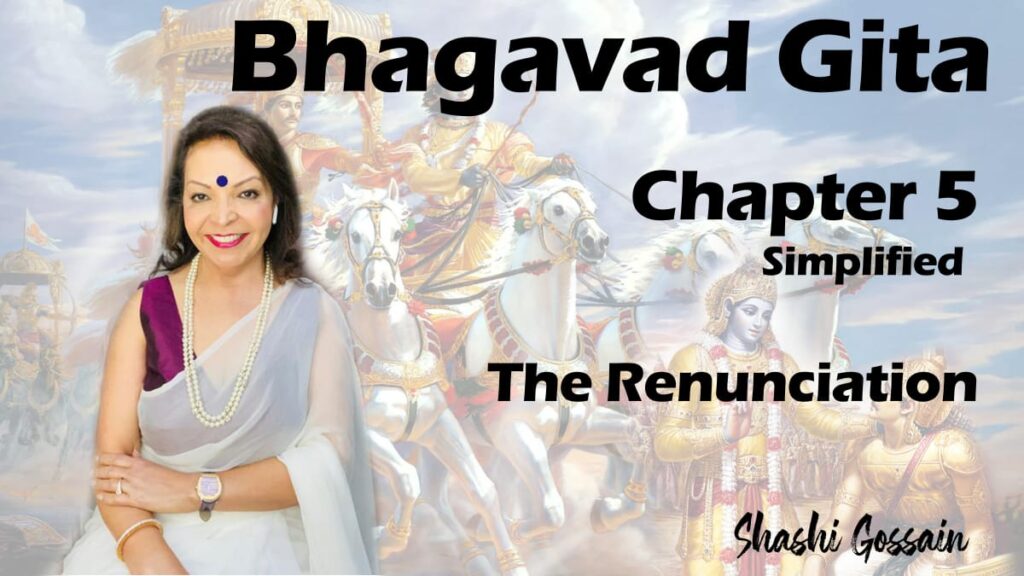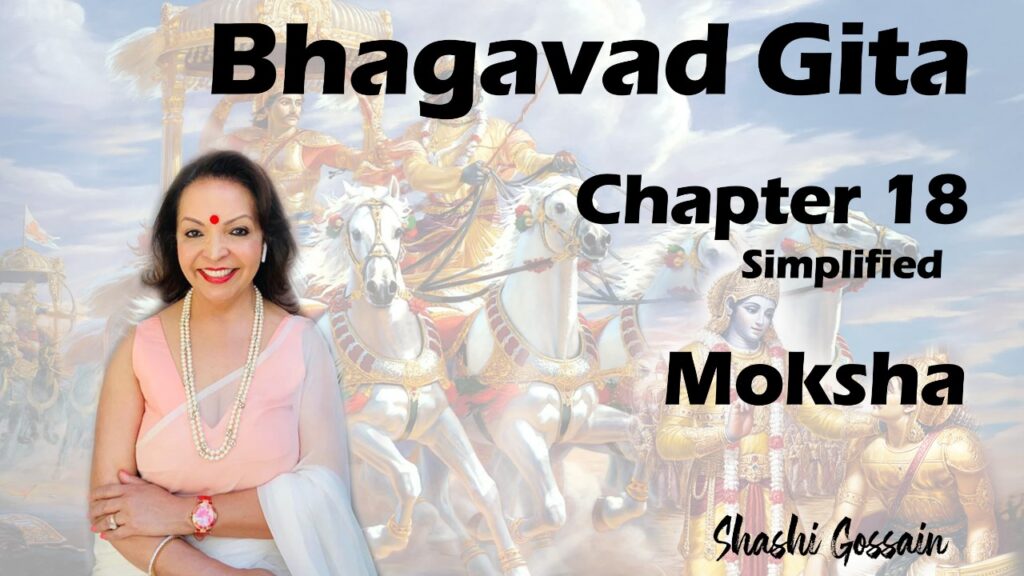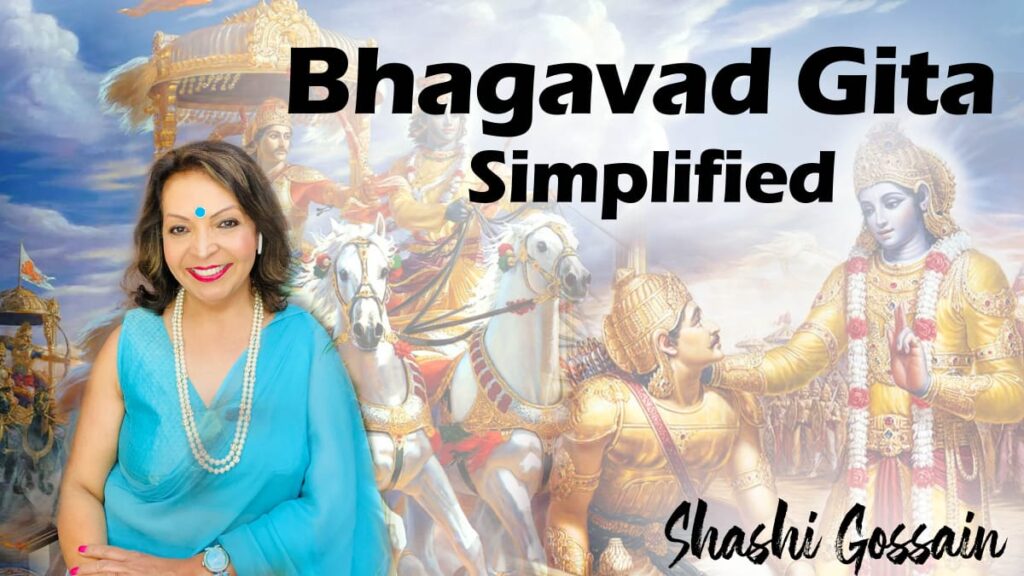In the Fifth Chapter of Shrimad Bhagavat Geeta Shri Krishna and Arjun talks about renunciation and Kama Sanyasa, eternal essence, Nirvana and so many things. Arjuna still retained a desire to run away from the war against his relatives. Then what does Krishna say to Arjuna?
What is the path of renunciation?
In the fourth chapter, Lord Kṛishna talked about knowledge and renunciation. He referred to the Wiseman as one whose karmas are burnt by the fire of knowledge.
Now, Arjuna still retained a desire to run away from the war against his relatives. So even though Shri Krishna was quite clear that one cannot run away from the action, Arjuna was still looking for a way to quit fighting the war.
So he interpreted the word “renunciation” to mean what most people think renunciation means: going away to a remote ashram, becoming a monk, and then contemplating upon the eternal essence, casting aside any otherworldly responsibilities.
With this interpretation in mind, Arjuna wanted to know which action was better:
- Renunciation
- Work in devotion.
If renunciation of action was better then, he could run away from the war to a place of contemplation, and gain self-realization following that path.
A teacher always takes into account the student’s stage in his learning progression, before he will advise a course of action.
Shri Krishna, the teacher, replies to Arjuna’s question by saying that for someone with Arjuna’s abilities, the yoga of action, karmayoga is a better path than the renunciation of action or karma sanyasa.
Like Arjuna, we too get tempted to run away from life when we are going through a tough time.
Therefore, having taken into account Arjuna’s mental make-up, knowing fully well that like us, Arjuna still had a lot of desires, Shri Krishna deemed that karma yoga was the right path for Arjuna, and that he was not well-suited to becoming a monk.
During the time of the Mahabhaarata war, and even now, there existed a fixed ideal of what it means to become a renouncer, which was that one runs away from the world to some remote place or ashram.
Shri Krishna needed to change that ideal completely. He stressed that a renouncer is one who completely gives up his ego, not external objects and situations.
In that regard, Shri Krishna says that we have to be free from three qualities before we can renounce the world. Freedom from:
- hatred or anger
- expectation of the future
- duality (likings/dislikings)
Only then is the next stage possible. This is called karma sanyasa.
Here the seeker minimizes actions other than those performed for gaining knowledge through the guidance of a teacher.
In both cases, of karma yoga and kama sanyasa, the goal of liberation will not be achieved, unless there’s a key ingredient, “the knowledge”.
The Lord Shri Krishna says that we should be alert of our desires all the time. If all actions are performed thoughtfully & without attachment to the result, our selfish desires will slowly get eliminated.
Shri Krishna has already listed all the sense organs & their functions in the previous chapter, so bodily functions are happening automatically.
But Arjuna asked about the process of thinking?’
Shri Krishna says that even the process of thought is happening automatically all the time with selfish desires or ego. But, as the ego gets eliminated through karma yoga, selfish thoughts slowly transition to selfless ones.
Till then, the “I” thinks that it is the doer.
For one who has realized the eternal essence, the self, or the “I”, is just the witness of all these actions.
According to Gita, What are the 4 types of attachment?
Krishnaji identified attachments at 4 levels. e.g for a musician, attachment to the:
- Action (I will sing a song only in my way)
- Result of action (I want a reward for singing this song)
- Sense of doership (I am singing this song)
- Sense of non-doership (By not singing the song, I am the non-singer of this song).
So therefore, the karma yogi strives to transcend all four levels of attachment by offering actions, results, do-ership and non-doership to Ishvara.
Shri Krishna goes on to say that the karma yogi continuously keeps the thought that the body, mind, intellect, and senses are the property of Ishvara, given by Ishvara.
Therefore, all the work done is for the benefit of Ishvara, and not for the ego.
The Gita teaches that the body, mind, intellect, and senses are not really “ours”.
But due to our conditioning, we come to think that they are ours.
We then begin to do things for their benefit. E.g. the tongue likes sweet food, so we undertake actions to satisfy it by eating things that may not be healthy from a long term perspective. When actions are done for the satisfaction of body, mind, intellect, and senses, the sense of “mine-ness” develops and the ego gets strengthened.
We then begin to serve the ego.
What is the power of dedication?
Arjun asked Lord Shri Krishna, What happens when karma yogi continues to dedicate actions to Ishvara?
Shri Krishna replied, ‘His mind gets cleared of all selfish desire, and his ego begins to lose its power. The end result is that the mind is purified of all desires. Purification of mind brings the karmayogi closer to self-realization.’
How do you do Karma Yoga?
The easiest way to gauge our progress towards karma yoga is to constantly monitor our state of mind. If we get agitated for long periods of time when we receive the result of our action, it is an indication that we have generated an attachment to the result, which in turn indicates that the ego is strong.
The enlightened seeker knows that he is the eternal essence, which is a dweller in the body and separate from the body.
The body in this shloka is metaphorically depicted as a city with nine gates, each gate being an orifice in a human body. (two eyes, two nostrils, two ears, the mouth, the anus, and the genital opening).
Krishnaji says, as long as we operate with body identification, we are similar to animals that also operate only at that level.
He compares the dispelling of ignorance to the dispelling of darkness by the sun. The light of the sun does not create anything new. It just shows us what was already there but was hidden by darkness. Similarly, the knowledge of the eternal essence does not create anything new in us.
It just reveals our true nature. The central theme of the Gita is the removal of delusion.
The root cause of delusion is ignorance, which is nothing but our identification with the body, mind, and intellect. All our efforts should be towards uprooting this ignorance through the correct knowledge.
There is always one aspect of our lives that is incomplete or imperfect. For some of us, it could be our job. For others, it could be our family and friends. For some others, it could be our health.
Given these various imperfections, we go through a roller coaster ride of joys and sorrows.
But if we take a truly objective look at this situation, it turns out that we are looking for perfection in the material world, which will always be imperfect.
Shri Krishna illustrates the personality of the seeker whose aspiration for the eternal essence is so intense that his entire personality resonates with that thirst for the eternal essence. His mind, intellect, conviction, goal – all these are aligned with the eternal essence.
It’s like a true musician: when you breathe, eat, sleep, walk and talk music. There is nothing in your life but music”. That statement reveals how much thirst a person has for his goal.
Once he gains the knowledge of the eternal essence, all dualities are the same, including the notion of joy/sorrow, hate/love, and friends/enemies.
How can you see friends & enemies the same?
The enlightened one will perceive a criminal and a saint with the same vision.
It’s the personality of the criminal that has the defect, not the eternal essence. The eternal essence is inherently defect-free.
Shri Krishna explains that attaining the eternal essence is possible here and now. We do not have to wait for another birth. Following the technique of karma yoga, we have to purify our mind and make it steady and harmonious, so that it can meditate on the eternal essence.
A wise person recognizes that every situation, no matter how good or bad, is part of nature & changes have no impact.
In nature, elements are interacting with the elements in multiple configurations.
For example, if we are on a boat, the ups and downs of the sea will impact us. But if we are standing on a rock on the shore, the ups and downs of the sea do not affect us.
Why do realized seekers remain unperturbed?
Their understanding of the eternal essence has become stable and firm. They have become “sthitha prajnya”. They are free from the delusion of doership.
Initially, when this knowledge is first gained, it stays on the surface. We experience the eternal essence sporadically, for a brief instant, then immediately go back into identification with the body/mind/intellect.
The Lord then starts turning us towards the topic of meditation. Turning oneself inwards, away from the sense objects of the world, is the first step towards meditation.
To this end, he explains the reason for turning inward. Our entire life is geared towards the pursuit of happiness. However, if we introspect, we realize that the happiness we get from sense objects such as tasty food or a visually appealing movie is instantaneous but fleeting. Since objects are finite, and so is the happiness that they can provide.
Moreover, if we are not careful, we get attached to whatever gives us instant happiness so that we can repeat that experience.
This also leads to sorrow, which comes from constant commentary and judgment from our minds when we don’t get sensory objects.
But Shri Krishna gives us a better alternative. When we slowly move away from sense objects and turn inward to contemplate on the eternal essence, we can tap into much greater internal happiness.
Moreover, this happiness is never-ending, because it is derived from within.
Shri Krishna provides another reason to turn away from sense pleasures. He says that pleasures born out of sense contacts are not really pleasures at all but are “wombs” of sorrow. This means a single experience of sense contact sows the seed for multiple sorrows.
We realize that the pleasure obtained by any of these objects is not just fleeting, but results in a chain of sorrows later. The mind is restless without constant sense contact.
Depending upon the strength of the desires that we have cultivated, it experiences a vacuum and rushes out into the material world towards an object in order to fill that vacuum.
At the same time, the eternal essence present within us identifies with the mind. It rushes out into the world, giving temporary joy. This joy was already within us. This joy is short-lived. Because the mind will again go out into the material world. Then the cycle of sorrow (vacuum) and joy (sense contact) will repeat itself.
This is called “samsaara”.
Shri Krishna urges us to become wise people and realize that sense contact is not the true source of joy.
Why does the mind rush out into the material world again?
Krishnaji says, there still exist two major obstacles to the realization:
- desire (the need to re-experience that sensory pleasure)
- anger( sorrowful circumstance)
Both of these generate impulses that cause the mind to go out into the material world.
Even though the seeker cannot get rid of desire and anger, but can check the impulses caused by them, that person will attain happiness from within than from without.
For the mind to realize the eternal essence, it needs to be even-keel. But these impulses take the mind outwards and destabilize it.
There will be an impulse within us to seek joy. Unless we redirect it inward, it will always rush outward. But if we redirect it inward and it does not find joy, it will again go outward. Therefore, turning this impulse inward has to be done intelligently. If all we do is cut ourselves off from the objects that give us pleasure, it will not work. Instead, we must work diligently towards the purification of our mind and performance of svaadhyaava, whether it is reading of scriptures or pooja and so on. As our mind finds exponentially more joy in svaadhyaaya, it will automatically turn inwards and drop its fascination with external objects.
How one can attain eternal essence?
Shri Krishna now describes how one attains the eternal essence, in other words, is liberated. This state is described by three words:
- Antaha-sukhaha: The person who finds bliss within. He does not expect anything from the outside world.
- Antaraaraa-maha: eliminated all agitations and is completely at ease with himself.
- Antar-jyotihi: the realized seeker knows that the eternal essence alone is the ultimate knowledge, the ultimate source of light.
The analogy is like that of the sun reflected in water. The reflection will never match the brightness of the sun itself. Similarly the joy obtained through the senses is “reflected happiness”. But a yogi who has shifted attention to his inner self gets the real form.
By such deep identification with the eternal essence, he becomes the eternal essence.
He attains the ultimate liberation or “nirvaana”. Such a liberated seeker is called a “rishi”. It means one who knows, one who has knowledge of the eternal essence. Typically, we think of a rishi as someone who has a beard and wears a robe. It is not so.
A rishi uses knowledge and discrimination constantly and knows the difference between the real and the unreal.
A Rishi has four attributes:
- Freed him of all mental impurities.
- Free from all doubts
- Complete self-control over his mind and senses
- State of total non-violence.
In the closing shlokas of the fifth chapter, Shri Krishna slowly begins pointing us toward meditation.
Meditation is the only way for the seeker to get fully established in the eternal essence.




This is a very good website. Ive been back a couple of times over the past week and wish to subscribe to your feed using Google but cannot learn the right way to do it very well. Do you know of any tutorials?